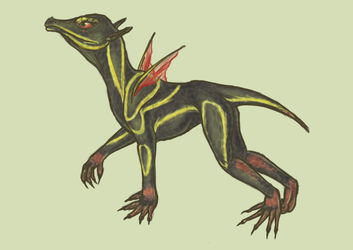Sign In
CloseSome older art from summer 2012!
The water scorpion, a Lutam species resembling a mix of serpent and crustacean.
These animals range in size from fifteen to twenty feet in length from snout to caudal fin and are most commonly found in the deep, murky waters of certain equatorial lagoons. The eyes of the scorpion have degraded into vestigial structures that are no longer visible on the surface; these animals navigate the cloudy water through detecting vibrations and heat in their environment. The long, thin tendrils extending from the carapace act to detect even minute changes in both temperature and water current while the powerful caudal fin helps to propel the animal forward.
It's highly uncommon for a Lutam invertebrate animal to reach the size of the water scorpion, but these creatures managed thanks to several factors. The scorpion's exoskeleton is incredibly sturdy and, together with the aquatic environment, prevents the animal's body from simply collapsing in on itself. This is why the scorpion's tendrils are so important: the carapace is so thick that the animal can't detect outside stimuli easily. Water scorpions also suffer from weak muscle strength due to their sheer size and the carapace again helps to counteract this by protecting the animal from outside threats.
Water scorpions especially excel in one aspect: their nervous system and cognition. Their brains are intricately wired in order to accurately process the information detected by their tendrils. Aside from monitoring their surroundings, water scorpions also put their complex brains to use while communicating with one another. The animals speak to each other through clicks and chirps; these noises are strung together to form words and sentences. Different populations of scorpions across the globe develop various languages and dialects for talking to one another.
It's worth noting that it's impossible for humans to even attempt communicating with water scorpions: scorpion vocals are too intricate for humans to replicate, even via technological means. The two animals have ranges that do not overlap in any case, however (humans can't thrive in Lutam's intensely hot equatorial region).
(and yes they are named after insects that they do not resemble in the slightest uhh)
Submission Information
- Views:
- 548
- Comments:
- 4
- Favorites:
- 1
- Rating:
- General
- Category:
- Visual / Digital







Link
Bandarai
Lovely job on the tones here. The fin on the tail is particularly great!